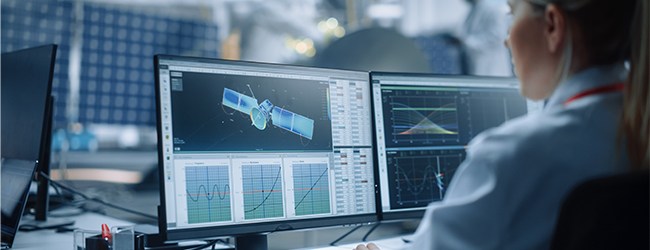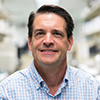Lubrication Trends: Requirements for Satellites & The Emergence of 'Small Space'
The space industry is ever expanding as new players join the quest to explore the great unknown. We sat down with Nye’s Aerospace Industry Manager, Tony Dotson, to discuss how these new players and their next generation technologies will affect what is required of space lubricants.

How has the proliferation of private space companies changed the Aerospace industry?
The private sector makes up the largest portion of today’s space economy and has more recently fueled the exponential growth and innovation of today’s space missions. Private companies have grown space-related business for decades, primarily in services relying on satellite communications such as GPS, broadband, and Satellite TV. The exponential growth over the past decade involves numerous start-up ventures with business models developed around providing a wide range of comprehensive mission capabilities and services. However, much of the recent advancement in innovative launch technology has continued to stem from government funded contracts that private companies compete for. This competition has fueled the leap in technology, innovation, and drive to reduce costs.
What innovations can we expect to emerge with this shift?
The ‘new’ space business model that pairs private companies with government contracted missions is proving to be a huge win-win for driving innovative technology. This has accelerated the growth of the space economy, setting the stage for the next global technology step change in connectivity, Internet of Things, Artificial Intelligence, and operation of autonomous vehicles. Additionally, the private space sector is leading further developments that are venturing off into completely new space business segments, such as space tourism, and potentially planet colonization. All of these new endeavors are further fueling a secondary emerging space arena, where the private business sector is already working on developing various space servicing businesses, such as spacecraft maintenance and repair, space junk removal, and rescue services for manned space travel and tourism. This adds countless new applications that require lubricants that can withstand the space environment.
More and more satellite constellations are being launched into space. What are the lubrication requirements for these applications?
Nye began working with NASA during the 1960’s Mercury Mission. Since then, Nye has continued to study and better understand the lubricant requirements for mission critical operation in space. Nye has taken these learnings and expertise and applied them to developing advanced test methods for simulating and evaluating the performance of lubricants and mechanisms in space.
There are a number of small sat constellations that have been approved for operation, some already in operation and growing in size, and many more constellations planned and in the works. There is no lack of innovative technology going into the many different small sat design which require an evolving range of mechanisms and unique operating requirements. All of this has driven the need to provide more customized lubricant solutions supported by relevant testing and performance data, and within compressed time constraints.
How does outgassing affect the performance of space lubrication? How does Nye measure lubricant outgassing under the conditions of space?
A lubricant’s ability to provide low outgassing performance in the vacuum environment of outer space is key. Lubricants typically operate under pressurized atmospheric conditions where evaporation losses can compromise a lubricant's integrity over time, and these evaporation losses are accelerated when operating in vacuum. Lubricants with lower outgassing means a lower loss of lubricant material over time, resulting in longer lubricant operating life and lower material loss. Low outgassing lubricants also help prevent undesired contamination of nearby components such as sensitive optics.
Nye has a number of ways to measure lubricant outgassing performance in our VAST (Vacuum, Aerospace, and Semiconductor Test) Lab, involving standardized test methods, as well as Nye-developed test methods. For space applications, ASTM E595 test data offers a good screening tool for outgassing performance, and Nye can readily perform this testing in-house. This test provides Total Mass Loss (TML) and Collected Volatile Condensable Materials (CVCM) under standard test conditions of 125°C and over 24 hours. This test method provides accelerated outgassing results and is a widely recognized screening process for assessing outgassing of a material used in the Aerospace industry.
What makes Pennzane-based lubricants unique compared to other vacuum lubricants on the market?
Nye has developed a wide range of space capable lubricants, based on both PFPE base oil chemistry and of course our unique Pennzane™ base oil chemistry. Nye’s Pennzane™ chemistry provides far superior film strength relative to PFPE chemistry, it is not susceptible to Lewis Acid degradation that can occur with PFPE chemistry, and Pennzane™ can further be adivated with soluble performance-enhancing additives. Nye’s Pennzane™ chemistry provides an unequaled level of wear protection and can provide extended operational life up to a magnitude greater than that of typical PFPE chemistry. Nye has, however, developed PFPE lubricants using the most advanced technology available, like NyeTorr® 6350EL, which does provide Lewis Acid resistance, significantly improved load-carrying ability, and much longer operating life versus heritage PFPE technology. Some of our Pennzane™ formulations are still in operation after more than two decades without issue.
About the Author

Tony Dotson is the Aerospace Industry Manager at Nye Lubricants. Tony has been an integral member of Nye for more than 15 years, finding lubrication solutions for our customers in the aerospace, industrial, semiconductor, vacuum, and cleanroom markets. Tony holds a Bachelor of Science degree in Mechanical Engineering from North Carolina State University and a Master of Science in Textile Technology from the Institute of Textile Technology.


